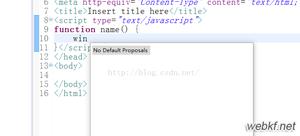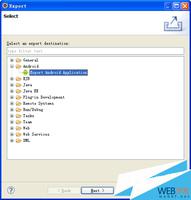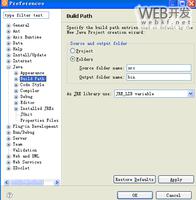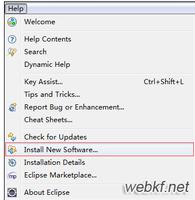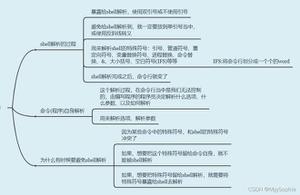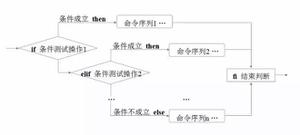Eclipse开发经典教程:展现组件
SWT中还有一些常用的组件,它们可以使组件更有表现力,且称之为展现组件,它们在SWT开发中也是不可缺少的,包括菜单组件、工具栏组件ToolBar和ToolItem、工具栏组件CoolBar和CoolItem、滚动组件Slider、刻度组件Scale和进度条组件ProgressBar等。菜单组件在程序中,菜单是提供信息比较好的方式,SWT中通过Menu和MenuItem实现菜单和菜单项,在程序中添加菜单的步骤如下。 (1)创建Menu对象,并指定创建的样式,例如“menuBar = new Menu(shell, SWT.BAR);”。 (2)创建MenuItem对象,并指定创建样式,例如“fileEnglishItem = new MenuItem (fileMenu, SWT.RADIO);”。 (3)设置Menu和MenuItem的关联(Menu中还可以有子Menu),例如“fileMenuHeader. setMenu(fileMenu);”。 (4)添加MenuItem的事件监听器,例如“fileEnglishItem.addSelectionListener(new RadioItemListener());”。为了更好地掌握菜单,下面通过一个实例演示如何创建菜单,代码如例程1所示。例程1 MenuExample.java
/*** 为了节省篇幅,所有的import类已经被注释
* 读者可以通过ctrl+shift+o快捷键,自动引入所依赖的类
* 如果有问题可发邮件到ganshm@gmail.com
*
*/publicclass MenuExample {Display display;
Shell shell;
Menu menuBar, fileMenu, editMenu;
MenuItem fileMenuHeader, editMenuHeader;
MenuItem fileExitItem, fileSaveItem, fileEnglishItem, fileGermanItem,
editCopyItem;
Text text;
public MenuExample() {display
=new Display();shell
=new Shell(display);shell.setText(
"Menu Example");shell.setSize(
300, 200);text
=new Text(shell, SWT.BORDER);text.setBounds(
80, 50, 150, 25);//添加主菜单项 menuBar =new Menu(shell, SWT.BAR);//添加一级子菜单 fileMenuHeader =new MenuItem(menuBar, SWT.CASCADE);fileMenuHeader.setText(
"&File");//添加一级子菜单的菜单项 fileMenu =new Menu(shell, SWT.DROP_DOWN);fileMenuHeader.setMenu(fileMenu);
fileSaveItem
=new MenuItem(fileMenu, SWT.PUSH);fileSaveItem.setText(
"&Save");fileEnglishItem
=new MenuItem(fileMenu, SWT.RADIO);fileEnglishItem.setText(
"English");fileGermanItem
=new MenuItem(fileMenu, SWT.RADIO);fileGermanItem.setText(
"German");fileExitItem
=new MenuItem(fileMenu, SWT.PUSH);fileExitItem.setText(
"E&xit");editMenuHeader
=new MenuItem(menuBar, SWT.CASCADE);editMenuHeader.setText(
"&Edit");editMenu
=new Menu(shell, SWT.DROP_DOWN);editMenuHeader.setMenu(editMenu);
editCopyItem
=new MenuItem(editMenu, SWT.PUSH);editCopyItem.setText(
"&Copy");//添加菜单项的事件监听器 fileExitItem.addSelectionListener(new MenuItemListener());fileSaveItem.addSelectionListener(
new MenuItemListener());editCopyItem.addSelectionListener(
new MenuItemListener());fileEnglishItem.addSelectionListener(
new RadioItemListener());fileGermanItem.addSelectionListener(
new RadioItemListener());shell.setMenuBar(menuBar);
shell.open();
while (!shell.isDisposed()) {if (!display.readAndDispatch())display.sleep();
}
display.dispose();
}
class MenuItemListener extends SelectionAdapter {publicvoid widgetSelected(SelectionEvent event) {text.setText(
"You selected "+ ((MenuItem) event.widget).getText());if (((MenuItem) event.widget).getText().equals("E&xit")) {shell.close();
}
}
}
class RadioItemListener extends SelectionAdapter {publicvoid widgetSelected(SelectionEvent event) {MenuItem item
= (MenuItem) event.widget;text.setText(item.getText()
+" is on.");}
}
publicstaticvoid main(String[] args) {MenuExample menuExample
=new MenuExample();}
}
以上程序中添加了主菜单,并在主菜单中添加了两个子菜单项,子菜单项添加了相应的事件响应机制,程序运行效果如图1所示。
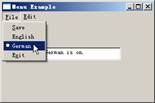 图1 Menu\MenuItem组件
图1 Menu\MenuItem组件
菜单是可以级联的,在子菜单中还能够包含其它的菜单项。
工具栏组件ToolBar和ToolItem ToolBar是SWT中的工具栏组件,ToolItem是工具栏中的工具项(一般表现为按钮或分隔符,也可以是其他组件),在程序中添加工具栏的步骤如下: 1. 创建ToolBar对象,并指定创建的样式,例如“toolBar = new ToolBar(shell, SWT.FLAT | SWT.WRAP | SWT.RIGHT);”。 2. 创建ToolItem对象,并指定创建样式,例如“ToolItem itemPush = new ToolItem (toolBar, SWT.PUSH);”。 3. 设置ToolItem的图标和相关属性,例如“itemPush.setImage(icon);”。 4. 添加ToolItem的事件监听器,例如“itemPush.addListener(SWT.Selection,selectionListener);”。为了更好地掌握工具栏组件,下面通过一个实例演示如何创建工具栏组件,代码如例程2所示。 例程2 ToolBarExample.java
publicclass ToolBarExample {Display display
=new Display();Shell shell
=new Shell(display);ToolBar toolBar;
public ToolBarExample() {//添加工具栏 toolBar =new ToolBar(shell, SWT.FLAT | SWT.WRAP | SWT.RIGHT);//添加工具项 ToolItem itemPush =new ToolItem(toolBar, SWT.PUSH);itemPush.setText(
"PUSH item");//设置工具项的显示图标//Image icon = new Image(shell.getDisplay(), "icons/new.gif");//itemPush.setImage(icon); ToolItem itemCheck =new ToolItem(toolBar, SWT.CHECK);itemCheck.setText(
"CHECK item");ToolItem itemRadio1
=new ToolItem(toolBar, SWT.RADIO);itemRadio1.setText(
"RADIO item 1");ToolItem itemRadio2
=new ToolItem(toolBar, SWT.RADIO);itemRadio2.setText(
"RADIO item 2");ToolItem itemSeparator
=new ToolItem(toolBar, SWT.SEPARATOR);final ToolItem itemDropDown
=new ToolItem(toolBar, SWT.DROP_DOWN);itemDropDown.setText(
"DROP_DOWN item");itemDropDown.setToolTipText(
"Click here to see a drop down menu ...");final Menu menu
=new Menu(shell, SWT.POP_UP);new MenuItem(menu, SWT.PUSH).setText("Menu item 1");new MenuItem(menu, SWT.PUSH).setText("Menu item 2");new MenuItem(menu, SWT.SEPARATOR);new MenuItem(menu, SWT.PUSH).setText("Menu item 3");//设置工具项的事件监听器 itemDropDown.addListener(SWT.Selection, new Listener() {publicvoid handleEvent(Event event) {if (event.detail == SWT.ARROW) {Rectangle bounds
= itemDropDown.getBounds();Point point
= toolBar.toDisplay(bounds.x, bounds.y+ bounds.height);//设置菜单的显示位置 menu.setLocation(point);menu.setVisible(
true);}
}
});
//设置工具项的事件监听器 Listener selectionListener =new Listener() {publicvoid handleEvent(Event event) {ToolItem item
= (ToolItem) event.widget;System.
out.println(item.getText() +" is selected");if ((item.getStyle() & SWT.RADIO) !=0|| (item.getStyle() & SWT.CHECK) !=0)System.
out.println("Selection status: "+ item.getSelection());}
};
itemPush.addListener(SWT.Selection, selectionListener);
itemCheck.addListener(SWT.Selection, selectionListener);
itemRadio1.addListener(SWT.Selection, selectionListener);
itemRadio2.addListener(SWT.Selection, selectionListener);
itemDropDown.addListener(SWT.Selection, selectionListener);
toolBar.pack();
shell.addListener(SWT.Resize,
new Listener() {publicvoid handleEvent(Event event) {Rectangle clientArea
= shell.getClientArea();toolBar.setSize(toolBar.computeSize(clientArea.width,
SWT.DEFAULT));
}
});
shell.setSize(
400, 100);shell.open();
while (!shell.isDisposed()) {if (!display.readAndDispatch()) {display.sleep();
}
}
display.dispose();
}
publicstaticvoid main(String[] args) {new ToolBarExample();}
}
程序添加了工具栏,并在工具栏中添加了相应的工具项,工具项中添加了相应的事件响应机制,程序运行效果如图2所示。
 图2 工具栏组件
图2 工具栏组件
本示例显示了工具栏和菜单栏的配合使用,菜单动态设定显示的位置。
工具栏组件CoolBar和CoolItem CoolBar是另外一种形式的工具栏,它能够调整CoolItem的位置,每一个CoolItem可以设定相关的组件(也可以是另一个工具栏),创建CoolBar的步骤如下: 1. 创建CoolBar对象,并指定创建的样式,例如“CoolBar composite = new CoolBar (parent, SWT.NONE);”。 2. 创建CoolItem对象,并指定创建样式,例如“CoolItem item = new CoolItem(composite, SWT.NONE);”。 3. 设置CoolItem的Control对象,例如“item.setControl(tb);”。 CoolBar相当于一个面板容器,CoolItem是容器中的每一项,CoolItem能设置相应的组件作为此项的子容器(也可以是其他组件)。为了更好地掌握CoolBar组件,下面通过一个实例演示如何创建CoolBar组件,代码如例程3所示。例程3 CoolBarExample.java
publicclass CoolBarExample extends ApplicationWindow {public CoolBarExample() {super(
null);}
protected Control createContents(Composite parent) {getShell().setText(
"CoolBar Test");String asCoolItemSection[]
= { "File", "Formatting", "Search" };//添加CoolBar CoolBar composite =new CoolBar(parent, SWT.NONE);for (int idxCoolItem =0; idxCoolItem <3; ++idxCoolItem) {CoolItem item
=new CoolItem(composite, SWT.NONE);//添加子组件 ToolBar tb =new ToolBar(composite, SWT.FLAT);for (int idxItem =0; idxItem <3; ++idxItem) {ToolItem ti
=new ToolItem(tb, SWT.NONE);ti
.setText(asCoolItemSection[idxCoolItem]
+" Item #"+ idxItem);}
Point p
= tb.computeSize(SWT.DEFAULT, SWT.DEFAULT);tb.setSize(p);
Point p2
= item.computeSize(p.x, p.y);//设置为一个CoolItem的控制类 item.setControl(tb);item.setSize(p2);
}
return composite;}
publicstaticvoid main(String[] args) {CoolBarExample app
=new CoolBarExample();app.setBlockOnOpen(
true);app.open();
Display.getCurrent().dispose();
}
}
以上代码演示了如何创建CoolBar。CoolBar中每一个CoolItem可以根据用户的需要调整位置,程序运行效果如图3所示。
 图3 CoolBar组件
图3 CoolBar组件
CoolBar和ToolBar的展现样式不一样,CoolBar可以动态调整工具栏的位置。
滚动组件Slider 为了方便用户输入数据,SWT中提供了Slider组件,用户可通过Slider设置数据的增量值,用来控制其他组件,也可以作为滚动条控制其他组件中的数据显示。添加Slider组件的步骤如下: 1. 创建Slider对象,并指定创建的样式,例如“Slider slide = new Slider(shell, SWT.HORIZONTAL);”。 2. 设置Slider的最大值和最小值,例如“slide.setMaximum(100);”。 3. 设置Slider增量的增加或递减值,例如“slide.setIncrement(1);”。 4. 添加Slider的事件监听器,例如“slide.addSelectionListener(selectionListener);”。为了更好地掌握Slider组件,下面通过一个实例演示如何创建Slider组件,代码如例程4所示。 例程4 SliderExample.java
publicclass SliderExample {Display dispaly;
Shell shell;
SliderExample() {
dispaly
=new Display();shell
=new Shell(dispaly);shell.setSize(
300, 250);shell.setText(
"A Slider Example");//添加Slider对象 final Slider slide =new Slider(shell, SWT.V_SCROLL);//设置Slider的位置和大小 slide.setBounds(170, 25, 25, 20);//设置Slider的最小值 slide.setMinimum(0);//设置Slider的最大值 slide.setMaximum(100);//设置Slider单击左右箭头的增加或递减值 slide.setIncrement(1);final Text t
=new Text(shell, SWT.BORDER);t.setBounds(
115, 25, 55, 20);t.setText(
"0");t.setFocus();
//添加Slider的事件监听器 slide.addSelectionListener(new SelectionAdapter() {publicvoid widgetSelected(SelectionEvent e) {t.setText(
new Integer(slide.getSelection()).toString());}
});
shell.open();
while (!shell.isDisposed()) {if (!dispaly.readAndDispatch())dispaly.sleep();
}
dispaly.dispose();
}
publicstaticvoid main(String[] args) {new SliderExample();}
}
以上代码添加了一个Text组件和一个Slider组件。Slider组件设置了增量值为1,另外Slider组件添加了选择事件,当选择了Slider组件后,Slider将为Text组件赋值。程序运行效果如图4所示。
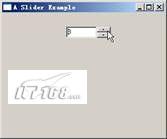 图4 Slider组件
图4 Slider组件
Slider组件要配合其它的组件使用,辅助其它的组件完成功能。
publicclass ScaleExample {Display display
=new Display();Shell shell
=new Shell(display);Scale scale;
Text value;
public ScaleExample() {shell.setLayout(
new GridLayout(1, true));Label label
=new Label(shell, SWT.NULL);label.setText(
"Volume:");//添加Scale组件 scale =new Scale(shell, SWT.VERTICAL);scale.setBounds(
0, 0, 40, 200);//设置Scale的最大值 scale.setMaximum(20);//设置Scale的最小值 scale.setMinimum(0);//设置Scale的增量值 scale.setPageIncrement(5);//添加Scale的事件监听器 scale.addListener(SWT.Selection, new Listener() {publicvoid handleEvent(Event event) {int perspectiveValue = scale.getMaximum() - scale.getSelection() +scale.getMinimum();
value.setText(
"Vol: "+ perspectiveValue);}
});
value
=new Text(shell, SWT.BORDER | SWT.SINGLE);value.setEditable(
false);scale.setLayoutData(
new GridData(GridData.HORIZONTAL_ALIGN_CENTER));value.setLayoutData(
new GridData(GridData.HORIZONTAL_ALIGN_CENTER));shell.pack();
shell.open();
while (!shell.isDisposed()) {if (!display.readAndDispatch()) {display.sleep();
}
}
display.dispose();
}
privatevoid init() {}
publicstaticvoid main(String[] args) {new ScaleExample();}
}
上例中,通过事件监听器监听当前选择的刻度,并用Text组件显示出来,程序运行效果如图5所示。
 图5 Scale组件
图5 Scale组件
Scale组件能够精确的显示刻度,用户可以设制好刻度的范围,这是非常有用的。
进度条组件ProgressBar ProgressBar是SWT中的进度条组件。进度条提供了比较长时间操作的进度信息。添加ProgressBar组件的步骤如下: 1. 创建ProgressBar对象,并指定创建的样式,例如“ProgressBar pb1 = new ProgressBar (shell, SWT.HORIZONTAL | SWT.SMOOTH);”。 2. 设置ProgressBar的最大值和最小值,例如“pb1.setMaximum(30);”。 3. 在长时间的任务中设置当前进度条的进度,例如“progressBar.setSelection (progressBar.getSelection() + 1);”。 进度条能反映当前的工作进度,为了配合处理长时间的任务,进度条经常配合线程使用,以免产生阻塞影响界面的操作。为了更好地掌握ProgressBar组件,下面通过一个实例演示如何创建ProgressBar组件,代码如例程6所示。例程6 ProgressBarExample.java
publicclass ProgressBarExample {publicstaticvoid main(String[] args) {Display display
=new Display();Shell shell
=new Shell(display);shell.setLayout(
new GridLayout());//添加平滑的进度条 ProgressBar pb1 =new ProgressBar(shell, SWT.HORIZONTAL | SWT.SMOOTH);pb1.setLayoutData(
new GridData(GridData.FILL_HORIZONTAL));//设置进度条的最小值 pb1.setMinimum(0);//设置进度条的最大值 pb1.setMaximum(30);//添加自动递增的进度条 ProgressBar pb2 =new ProgressBar(shell, SWT.HORIZONTAL |SWT.INDETERMINATE);
pb2.setLayoutData(
new GridData(GridData.FILL_HORIZONTAL));//添加线程,在线程中处理长时间的任务,并最终反映在平滑进度条上 new LongRunningOperation(display, pb1).start();shell.open();
while (!shell.isDisposed()) {if (!display.readAndDispatch()) {display.sleep();
}
}
}
}
class LongRunningOperation extends Thread {private Display display;private ProgressBar progressBar;public LongRunningOperation(Display display, ProgressBar progressBar) {this.display = display;this.progressBar = progressBar;}
publicvoid run() {//模仿长时间的任务 for (int i =0; i <30; i++) {try {Thread.sleep(
1000);}
catch (InterruptedException e) {}
display.asyncExec(
new Runnable() {publicvoid run() {if (progressBar.isDisposed()) return;//进度条递增 progressBar.setSelection(progressBar.getSelection() +1);}
});
}
}
}
以上代码添加了两个进度条,一个进度条为自动显示增加进度的信息(SWT.INDETERMINAT样式),另外一个进度条通过线程处理长时间的任务,并设定进度条的信息。程序运行效果如图6所示。
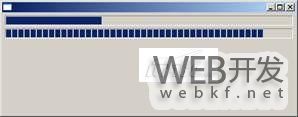 图6 ProgressBar组件
图6 ProgressBar组件
进度条有不同的样式,在程序中,开发人员可以控制进度条的进度,执行某些长时间的操作。
以上是 Eclipse开发经典教程:展现组件 的全部内容, 来源链接: utcz.com/p/206023.html

